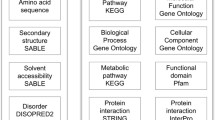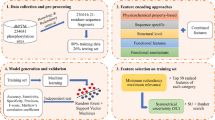Abstract
Protein tyrosine kinases (PTKs) play a central role in the modulation of a wide variety of cellular events such as differentiation, proliferation and metabolism, and their unregulated activation can lead to various diseases including cancer and diabetes. PTKs represent a diverse family of proteins including both receptor tyrosine kinases (RTKs) and non-receptor tyrosine kinases (NRTKs). Due to the diversity and important cellular roles of PTKs, accurate classification methods are required to better understand and differentiate different PTKs. In addition, PTKs have become important targets for drugs, providing a further need to develop novel methods to accurately classify this set of important biological molecules. Here, we introduce a novel statistical model for the classification of PTKs that is based on their structural features. The approach allows for both the recognition of PTKs and the classification of RTKs into their subfamilies. This novel approach had an overall accuracy of 98.5% for the identification of PTKs, and 99.3% for the classification of RTKs.
Similar content being viewed by others
References
Boeckmann, B., Bairoch, A., Apweiler, R., Blatter, M.-C., Estreicher, A., Gasteiger, E., Martin, M.J., Michoud, K., O’Donovan, C., Phan, I., et al. (2003). The SWISS-PROT protein knowledge-base and its supplement TrEMBL in 2003. Nucleic Acids Res 31, 365–370.
Carrera, A.C., Borlado, L.R., Roberts, T.M., and Martinez A.C. (1994). Tyrosine kinase specific motif at subdomain VIII does not confer specificity for tyrosine. Biochem. Biophys. Res. Commun. 205, 1114–1120.
Chiarugi, P. (2008). Src redox regulation: There is more than meets the eye. Mol. Cells 26, 329–337.
Chu, D.H., Spits, H., Peyron, J.-F., Rowley, R.B., Bolen, J.B., and Weiss, A. (1996). The Syk protein tyrosine kinase can function independently of CD45 or Lck in T cell antigen receptor signaling. EMBO J. 15, 6251–6261
Dean, M., Park, M., Le Beau, M.M., Robins, T.S., Diaz, M.O., Rowley, J.D., Blair, D.G., and Vande Woude, G.F. (1985). The human met oncogene is related to the tyrosine kinase oncogenes. Nature 318, 385–388.
Eddy, S.R. (1998). Profile hidden markov model. Bioinformatics 14, 755–763.
Eo, H.S., Choi, J.P., Noh, S.J., Hur, C.G., and Kim, W. (2007). A combined approach for the classification of G protein-coupled receptors and its application to detect GPCR splice variants. Comput. Biol. Chem. 31, 246–256.
Gaulton, A., and Attwood, T.K. (2003). Bioinformatics approaches for the classification of G-protein-coupled receptors. Curr. Opin. Pharmacol. 3, 114–120.
Grundy, W.N., Bailey, T.L., Elkan, C.P., and Baker, M.E. (1997). Meta-MEME: Motif-based hidden Markov models of protein families. Comput. Appl. Biosci. 13, 397–406.
Hanks, S.K., and Hunter, T. (1995). The eukaryotic protein kinase superfamily: kinase (catalytic) domain structure and classification. FASEB 9, 576–579.
Hanks, S.K., and Quinn, A.M. (1991). Protein kinase catalytic domain sequence database: Identification of conserved features of primary structure and classification of family members. Methods Enzymol. 200, 38–62.
Hanks, S.K., Quinn, A.M., and Hunter, T. (1988). The protein kinase family: conserved features and deduced phylogeny of the catalytic domains. Science 241, 42–52.
Hubbard, S.R., and Till, J.H. (2000). Protein tyrosine kinase structure and function. Ann. Rev. Biochem. 69, 373–398.
Hunter, T. (1991). Protein kinase classification. Methods Enzymol. 200, 3–37
Karchin, R., Karplus, K., and Haussler, D. (2002). Classifying G-protein coupled receptors with support vector machines. Bioinformatics 18, 147–159.
Kong, A., Calleja, V., Leboucher, P., Harris, A., Parker, P.J., and Larijani, B. (2008). HER2 oncogenic function escapes EGFR tyrosine kinase inhibitors via activation of alternative HER receptors in breast cancer cells. PLoS One 3, e2881.
Krogh, A. (1998). Computational methods in molecular biology. In S.L., Salzberg, D.B., Searls, and S., Kasif, eds. (Amsterdam: Elsevier Science B.V.), pp. 45–64.
Manning, G., Whyte, D.B., Martinez, R., Hunter, T., and Sudarsanam, S. (2002). The protein kinase complement of the human genome. Science 298, 1912–1934.
Melodelima, C., Gueguen, L., Piau, D., and Gautier, C. (2006). A computational prediction of isochores based on hidden Markov models. Gene 385, 41–49.
Mendelsohn, J., and Baselga, J. (2000). The EGF receptor family as targets for cancer therapy. Oncogene 19, 6550–6565.
Mitrophanov, A.Y., and Borodovsky, M. (2006). Statistical significance in biological sequence analysis. Brief Bioinform. 7, 2–24.
Neet, K., and Hunter, T. (1996). Vertebrate non-receptor protein-tyrosine kinase families. Genes Cells 1, 147–169.
Partanen, J., Puri, M.C., Schwartz, L., Fischer, K.D., Bernstein, A., and Rossant, J. (1996). Cell autonomous functions of the receptor tyrosine kinase TIE in a late phase of angiogenic capillary growth and endothelial cell survival during murine development. Development 122, 3013–3021.
Pearson, R.B., and Kemp, B.E. (1991). Protein kinase phosphorylation site sequences and consensus specificity motifs: Tabulations Methods Enzymol. 200, 62–81.
Robertson, S.C., Tynan, J.A., and Donoghue, D.J. (2000). RTK mutations and human syndromes. Trends Genet. 16, 265–271.
Robinson, D.R., Wu, Y.-M., and Lin, S.-F. (2000). The protein tyrosine kinase family of the human genome. Oncogene 19, 5548–5557.
Sadka, T., and Linial, M. (2005). Families of membranous proteins can be characterized by the amino acid composition of their transmembrane domains. Bioinformatics 21, i378–i386.
Sgourakis, N.G., Bagos, P.G., and Hamodrakas, S.J. (2005a). Prediction of the coupling specificity of GPCRs to four families of G-proteins using hidden Markov models and artificial neural networks. Bioinformatics 21, 4101–4106.
Sgourakis, N.G., Bagos, P.G., Papasaikas, P.K., and Hamodrakas, S.J. (2005b). A method for the prediction of GPCRs coupling specificity to G-proteins using refined profile hidden Markov models. BMC Bioinformatics 6, 104.
Sridhar, R., Hanson-Painton, O., and Cooper, D.R. (2000). Protein kinases as therapeutic targets. Pharm. Res. 17, 1345–1353.
Tidow, C.M., Schwable, J., Steffen, B., Tidow, N., Brandt, B., Becker, K., Bahr, E.S., Halfter, H., Vogt, U., Metzger, R., et al. (2004). High-throughput analysis of genome-wide receptor tyrosine kinase expression in human cancers identifies potential novel drug targets. Clin. Cancer Res. 10, 1241–1249.
Ullrich, A., Bell, J.R., Chen, E.Y., Herrera, R., Petruzzelli, L.M., Dull, T.J., Gray, A., Coussens, L., Liao, T.-C., Tsubokawa, M., et al. (1985). Human insulin receptor and its relationship to the tyrosine kinase family of oncogenes. Nature 313, 756–761.
Wang, Y-F., Chen, H., and Zhou, Y.-H. (2005). Prediction and classification of human G-protein coupled receptors based on support vector machines. Genomics Proteomics Bioinformatics 3, 242–246.
Weinert, W.R., and Lopes, H.S. (2004). Neural networks for protein classification. Appl. Bioinformatics 3, 41–48.
Author information
Authors and Affiliations
Corresponding author
About this article
Cite this article
Park, HC., Eo, HS. & Kim, W. A computational approach for the classification of protein tyrosine kinases. Mol Cells 28, 195–200 (2009). https://doi.org/10.1007/s10059-009-0122-z
Received:
Accepted:
Published:
Issue Date:
DOI: https://doi.org/10.1007/s10059-009-0122-z




